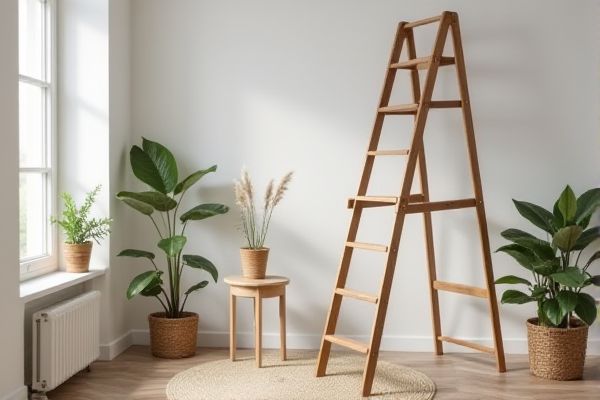
A rolling ladder offers enhanced safety and stability for reaching higher shelves, making it ideal for libraries or warehouses, while a step stool is more portable and convenient for quick tasks around the home or office. Explore the rest of the article to determine which option best suits your needs and ensures your safety.
Table of Comparison
| Feature | Rolling Ladder | Step Stool |
|---|---|---|
| Mobility | Equipped with wheels for easy movement | Usually stationary, no wheels |
| Height | Taller, suitable for high shelves and industrial use | Lower height, ideal for short tasks |
| Stability | Stable with locking wheels and wide steps | Stable on flat surfaces but less sturdy than rolling ladders |
| Portability | Heavier, less portable due to size and wheels | Lightweight and easy to carry |
| Use Case | Best for warehouses, libraries, and workplaces requiring frequent movement at height | Best for home, small tasks, quick reach |
| Cost | Generally more expensive | Affordable and budget-friendly |
Introduction to Rolling Ladders and Step Stools
Rolling ladders offer increased height and mobility, ideal in warehouses and libraries for accessing high shelves safely, while step stools provide compact, portable support for lower reaches around the home or office. Both tools are designed to enhance your safety and convenience when reaching elevated areas, but rolling ladders typically feature wheels and handrails for added stability. Choosing between a rolling ladder and step stool depends on the height requirements and frequency of use in your environment.
Key Differences Between Rolling Ladders and Step Stools
Rolling ladders feature wheels for easy mobility and typically offer greater height and stability, making them ideal for accessing high shelves in warehouses or libraries. Step stools are compact, lightweight, and designed for quick, low-height tasks around the home or office, prioritizing portability over reach. Your choice depends on the required height and frequency of use, with rolling ladders suited for heavy-duty, repetitive tasks and step stools for casual, occasional use.
Safety Features Comparison
Rolling ladders feature sturdy handrails, wide non-slip steps, and locking casters to prevent movement, enhancing stability during use. Step stools typically offer slip-resistant treads and lightweight designs but lack the additional support and mobility controls found on rolling ladders. For industrial or frequent access tasks, rolling ladders provide superior safety through enhanced balance and secure positioning compared to step stools.
Space and Storage Considerations
Rolling ladders offer a compact, vertical storage solution often integrated into shelving units, making them ideal for maximizing space in libraries or warehouses. Step stools are smaller and more portable but require convenient storage spots when not in use, potentially leading to clutter in tight areas. Choosing between the two depends largely on available space and the need for permanent versus temporary access solutions.
Weight Capacity and Durability
Rolling ladders typically offer a higher weight capacity, supporting up to 500 pounds or more, making them ideal for industrial and warehouse use. Step stools generally have a lower weight capacity, averaging between 200 to 300 pounds, suitable for household tasks. The durability of rolling ladders is enhanced by heavy-duty steel construction and reinforced steps, while step stools often use lighter materials like aluminum or plastic, impacting their longevity under frequent heavy loads.
Ease of Use and Mobility
Rolling ladders offer superior ease of use with their smooth-rolling casters, allowing quick repositioning across various floor types without lifting. Step stools are lightweight and compact, making them highly portable but require manual carrying and placement. For frequent vertical access in large spaces, rolling ladders provide enhanced mobility and ergonomic efficiency compared to step stools.
Typical Applications in Homes and Workplaces
Rolling ladders are commonly used in warehouses and libraries for accessing high shelves and heavy inventories, providing stability and mobility with their casters and wide steps. Step stools are preferred in homes and offices for quick tasks like reaching kitchen cabinets or filing shelves due to their compact size and lightweight design. Both tools enhance safety and efficiency by offering secure height elevation tailored to specific environments and task frequency.
Cost Analysis: Rolling Ladder vs Step Stool
Rolling ladders typically incur higher initial costs ranging from $500 to $2,000 due to their durable construction and safety features, while step stools are more budget-friendly, generally priced between $20 and $100. Maintenance expenses for rolling ladders can include periodic wheel lubrication and structural inspections, whereas step stools require minimal upkeep, often limited to basic cleaning. Considering long-term value, rolling ladders offer enhanced stability and height access for industrial use, justifying their higher price, whereas step stools suit occasional household tasks with lower investment.
Pros and Cons of Rolling Ladders
Rolling ladders offer enhanced mobility and safety with their sturdy wheels and handrails, making them ideal for large warehouses or libraries where frequent moving is necessary. Their height versatility allows access to higher shelves compared to most step stools, but they require more storage space and can be heavier to maneuver. Unlike step stools, rolling ladders provide greater stability on uneven surfaces, though they tend to have a higher cost and maintenance needs due to moving parts.
When to Choose a Step Stool Over a Rolling Ladder
Choose a step stool over a rolling ladder when you need a lightweight, portable solution for quick tasks that require limited height, such as reaching low shelves or cabinets. Step stools are ideal for compact spaces where maneuverability is essential and stability on uneven surfaces is necessary, unlike rolling ladders designed for taller, stationary access. Your decision should prioritize ease of use, storage convenience, and the specific height requirements of the task.
 homyna.com
homyna.com